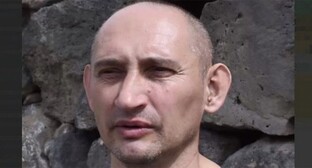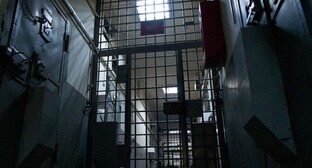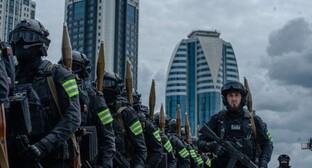27 May 2003, 13:03
Azov
Rayon (sector) centre, town of oblast subordination in Rostov oblast (province), 42 km south-west of Rostov-on-Don. Located on the left bank of the Don, 7 km of its influx into Taganrog Gulf of the Sea of Azov. Marine and river harbour, terminal railway station in a branch from the Rostov-on-Don - Baku line. Population (1992 est.) 80.9 thousand, (1959 est.) 39.9 thousand, (1970 est.) 59 thousand, (1979 est.) 76.8 thousand.
Since the 1st - 3rd centuries, there were two Maeotae-Scythian settlements in the area of modern Azov. They were mentioned by Ptolemaips (2nd century) under the names of Paniardis and Patarva and belonged to the system of fortified settlements around Tanais, a city of the Kingdom of the Bosporus, which was the northernmost point of the antique civilisation on the Black Sea Coast. In the 10th - 12th centuries, the site of present Azov was occupied by a Slavic settlement belonging to the old Russian Tmutarakan Princedom. According to one of the versions, it was founded in 965 or 966, when Svyatoslav, the Prince of Kiev, who had defeated the Khazars, gave the Turk-Oguz, who were allied to him, lower reaches of the Don to possess. It was around here that the Polovtsian Prince Azun, from whose name the Russian word Azov seems to be derived, was killed in about 1067 when the Polovtsians were conquering Priazov. According to another version, the toponym of Azov was derived from the Turkic azak (аdаk) for the mouth of the river or a low marshy place. In the 13th century, the town of Azak arose on this site, through which the great trade route to China passed. In Azov, the main harbour of the Sea of Azov, the most important trade routes of the Middle Ages intersected: the Volga-Kama Route from Russia and Bulgaria to Constantinople, from Western Europe to Persia, India and China. In autumn of 1395, the town was destroyed by troops of Timur (Таmerlane). In the early 15th century, it loses its significance of a world trade centre. In autumn of 1471, Azov was seized by the Turks and turned into a Turkish military fortress. The outskirts were fortified with earthworks and ditches. A stony wall with 11 towers was erected from the side of the Don. In the 17th century, the fortress of Azov prevented Don Cossacks from putting to sea on their vessels into the Sea of Azov and the Black Sea for trade and raids. In June 1637, groups of Don and Zaporozhye Cossacks took the fortress by storm after a two-month siege. In summer 1641, Turkey forwarded a strong fleet and overland troops to the walls of Azov to capture it. However, the siege of the fortress by the Turks, proceeding from June to September of the same year, ended without result (the so-called Azov sitting). In summer 1642, the Cossacks destroyed the fortifications and left Azov (they were later re-fortified by the Turks). In 1695, troops of Peter I besieged Azov from the dry land during the first Azov campaign. After two unsuccessful storms, the siege was removed. In summer 1696, Russian troops took Azov with assistance of the Azov flotilla (the ships were built in Voronezh in winter 1695-1696).
In 1708, Azov became a city, the centre of the Azov government (province). After the unsuccessful Prut campaign (1711) of Russian troops, Azov was regained by Turkey. The Don Army of General P.P. Lasy with assistance of the Don flotilla of Vice-Admiral P.P. Bredal took Azov in June 1736 during the Russian-Turkish War of 1735-1739. However, Azov and Taganrog were included into barrier (neutral) grounds under the Belgrad Peace (1739); fortifications and constructions in them were destroyed. In 1769, Azov was occupied by Russian troops under command of P.А. Rumyantsev during the Russian-Turkish War of 1768-1774. In 1774, Azov was conclusively attached to Russia under the Treaty of Kucuk Kaynarca. In the late 18th and the early 19th centuries, Azov was a boundary flank fortress in the Azov- Mozdok line (abolished in 1810). Azov was the centre of Azov government in 1776-1782, at a loose end since 1784, a posad (industrial centre) of the Rostov uyezd (canton) of Yekaterinoslav government since 1801, within the Don Cossack Area in 1888. In 1926, Azov obtained the town status.
Modern Azov is an industrial centre. The leading branch of industry is machine-building. The city produces press-forging equipment, press forging automatic machines, shop equipment, electromechanical articles (complete transformer substations), etc. It has enterprises of light industry (a clothes factory, a shoe factory, production of hosiery, etc.), food-processing industry (including canning one), furniture industry, a factory producing proteinaceous vitaminised additives, production of building materials (including ferro-concrete constructions).
The town has a museum of local lore (history of the town, archaeological findings within the area of the Lower Don and the Azov) and the memorial museum of R.L. Samoylovich, a researcher of the Arctic Region (born in Azov). It was in Azov that the writer G.I Miroshnichenko, who was an honorary freeman and the author of the novels Azov, Siege of Azov, was buried.
The former Turkish fortress reminds of itself with high earthworks on the left bank of the Don (the height ranging from 5 to 15 m, width at the basis from 10 to 30 m) and the moat. Instead of original 11 gates, Alekseyevsky Gates (1801 - 1805) and bases of Troitsky Gates, the powder cellar (1799; at present it houses the exposition of the museum of local lore, including the diorama The Azov Campaign of Peter I in 1696 by the artist A. Chernyshyov) have only remained. Inside the fortress, there is a labyrinth of narrow twisting streets, adobe and cob houses of the 19th century. Behind the walls, in the south-west end of the town, there is the Podazovskoye site of an ancient settlement (diggings resulted in finding antique amphorae, moulded ceramics, household and agricultural tools of Maeotae-Scythian tribes). In the late 19th and the early 20th centuries, a shopping arcade (1912), buildings of the town council (1892, the present museum of local lore), a female progymnasium (1906) were built, thus forming a new town centre.




